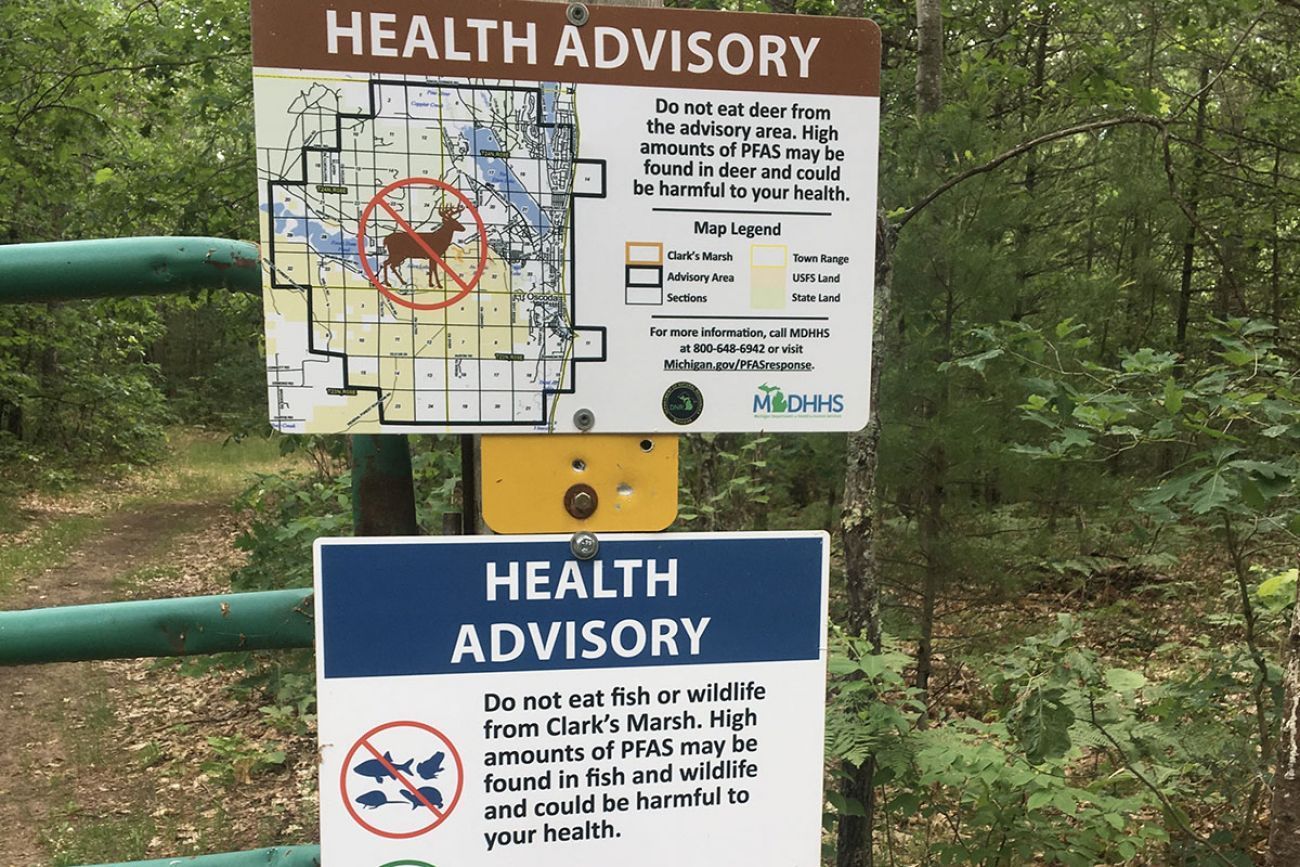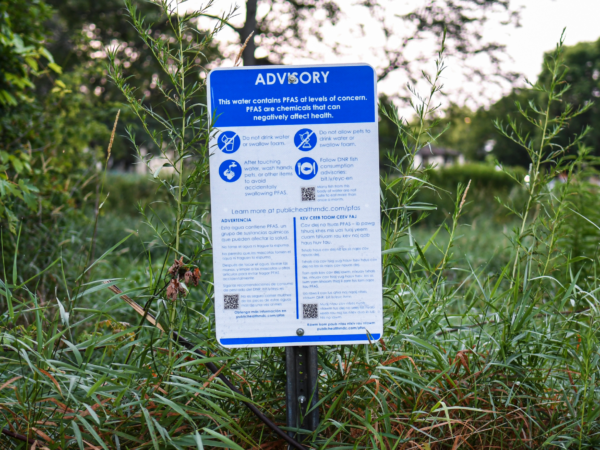
By Mike Wilkinson, Bridge Michigan
The Great Lakes News Collaborative includes Bridge Michigan; Circle of Blue; Great Lakes Now at Detroit Public Television; and Michigan Radio, Michigan’s NPR News Leader; who work together to bring audiences news and information about the impact of climate change, pollution, and aging infrastructure on the Great Lakes and drinking water. This independent journalism is supported by the Charles Stewart Mott Foundation. Find all the work HERE.
- Pentagon announces plan to halt flow of PFAS compounds into groundwater at former Wurtsmith base in Oscoda
- Political leaders hailed the ‘interim’ before a final cleanup plan is adopted
- PFAS compounds have been linked to thyroid, developmental, fertility, hormone and immunity issues and to cancer
The U.S. military has agreed to install groundwater treatment systems to stop the flow of PFAS contamination around the former Wurtsmith Air Force Base in Oscoda — a move hailed by politicians and local advocates.
The decision, first announced in Oscoda Wednesday, is seen as a first-in-nation step by the U.S. Defense Department to take quicker action to contain the compound from spreading, and follows years of criticism from local and state officials about the commitment and pace of military efforts to address the environmental harm.
PFAS exposure has been linked to thyroid problems, developmental issues, hormone and immunity challenges, fertility issues and cancer and local officials have been calling upon the military to take more overt “interim” measures before a final PFAS cleanup plan, still being developed, is approved and completed.
“The national significance of this is the Pentagon has taken our plan … and turned it into a national policy directive,” said Tony Spaniola, a Troy attorney and a leader of the Oscoda-based Need Our Water group. He owns a home along Van Etten Lake in Oscoda.
The military will build wells, install pumps and treat groundwater at two of the four sites where plumes of PFAS have been spreading toward local lakes, marshes and rivers, officials said.
“For far too long, Oscoda and surrounding communities have lived with the impact of PFAS contamination created by the Department of Defense,” said U.S. Rep. Elissa Slotkin, D-Lansing, in a press release. “The actions announced last night — adding groundwater treatment systems at two new sites — are a positive step forward, even with much more work to do.”
There are hundreds of military sites around the nation facing PFAS issues. Wurtsmith was the first chosen for interim action after the Pentagon in July ordered all military branches to determine if “interim action can be taken to mitigate further PFAS plume migration….”
“Implementation of these new interim actions is a step in the right direction for the Wurtsmith community,” William LaPlante, an under secretary of defense, said in a statement released Thursday, while adding that there is still more work to do.
“This will stop the flow of PFAS-impacted groundwater from both source areas into nearby Van Etten Lake,” LaPlante said. The military will will work with the Michigan Department of Environment, Great Lakes, and Energy and other local government and community groups, he said.
The former air force base sits west of Lake Huron and north of Bay City and was home to B-52 bombers for years before being decommissioned in 1993. It was identified as the first military PFAS contamination site in 2010.
Michigan’s EGLE lists 14 military sites with known PFAS contamination in Michigan but also over 240 other sites, including most commercial airports like Detroit Metropolitan Airport and Gerald Ford International Airport in Kent County.
The military adopted a fire retardant foam that used PFAS during the Vietnam War after a devastating fire aboard an aircraft carrier killed 134 U.S. sailors. It was widely used by the military for decades and is still used at airports for fire suppression.
The fire-fighting foam was used all across the airbase when it was operational, with fire crews training with it regularly, and its dispersal is widespread. It has been found moving into Van Etten Lake to the northeast of the base and south into Clark’s Marsh and the AuSable River.
PFAS is part of a widely-used class of chemicals that is used in everything from nonstick pans to fast food wrappers. Because it can take years to break down, PFAS compounds are considered “forever chemicals.”
The Pentagon’s decision, however, affects just two of four areas identified as sources of significant PFAS contamination in and around Wurtsmith and Slotkin and others had pushed the military to address all four.
But Spaniola, long a critic of the Pentagon, said Thursday he is optimistic the other two will be addressed.
Currently, the military has filtration systems in the four areas. Spaniola and others had been pushing for a better system, one that acts as a “tourniquet” to stanch the flow of PFAS as the region awaits a fuller cleanup.
Spaniola said he believes the installation of pumps, wells and water treatment should “stop the bleeding.”
U.S. Sen. Gary Peters, D-Michigan, lauded the decision Thursday during an appearance in Lansing.
“The citizens have been aggressive and stayed on it,” Peters told Bridge Michigan, describing the Pentagon’s announcement as “significant.”
The decision follows years of requests for additional cleanup, Including from local, state and federal officials who’ve backed the Wurtsmith cleanup.
Peters said the pressure finally resulted in the move. However, he added, scrutiny will need to continue.
“We have to stay on them,” Peters said of the DOD. “They’ve also made promises in the past.”
Bridge reporter Paula Gardner contributed to this report.




